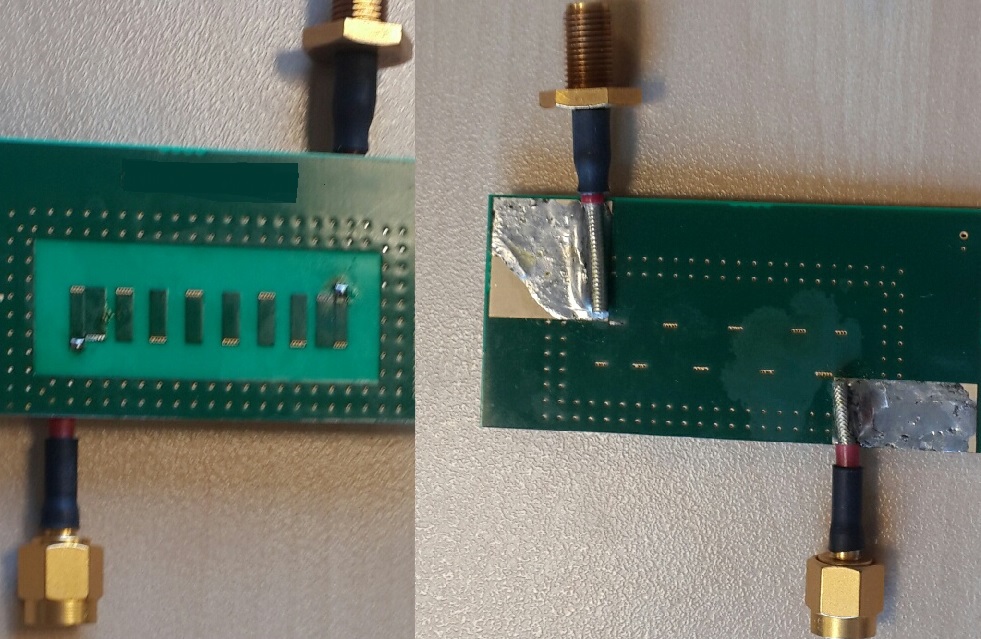Microstrip filter implementation ripple problem
I have designed an X band interdigital bpf on ADS Momentum and implemented it. On implementation I have a ripple problem like about 1 dB that I don't see on simulation. I have simulated exactly the same geometry that I have put on pcb but there are no ripples on simulation. What do you think I am missing on simulation? I am adding tangent loss, copper thickness, conductivity etc. What can cause these ripples?
Thank you in advance
They may come from wrong designed coupling factors.I mean, coupling factors between the sections are low than predicted.
Difficult to say without seeing the results. It could be tolerances in dimensions (etching precision) or the transition from coax to microstrip. Also, for these coupled structures the simulation mesh density (especially at the edges) matters.
and, it could easily be the substrate itself. Dielectric constant or dielectric thickness can vary significantly from lot to lot.
True. I was assuming that a well defined "good" microwave substrate was used, with controlled small tolerances.
I used Rogers substrate good for these frequencies. I have both configuration, transition from microstrip to coax and microstrip to directly sma connector. They both have ripples but differently, not exactly the same type. If it is because of that, how can I be sure?
I couldn't understand, can you clarify wrong designed coupling factor? I used filter design tool for design and simulated the layout both on momentum and EMPRO.
Ok, if this changes the ripple, then the coax connection has some negative effect. Can you show a picture of your coax-to-pcb connection?
To compare with simulation, you would use TRL calibration (or similar) with a microstrip test fixture. This has microstrip calibration standards (not coax) and the coax-to-pcb transition is removed from results.
You mean if I use TRL calibration on network analyzer it doesn't calibrate coax-to-pcb transition right? I use TRL calibration on NA and still see ripples on sma connected filter. Did I get you right?
The picture of coax to pcb is here:

Thank you very much
If you use TRL and the coax-to-pcb transition is perfectly identical and reproducible then the transition will be removed by TRL calibration. So your approach with TRL is fine, if the coax-to-pcb transition is really the same in cal standards and device under test.
Your picture shows that you coax is rather large (relative to filter dimensions). As far as I can see, you tried to minimizing the discontinuity, but anyway: bending the center conductor upwards this way is certainly more inductive than having an SMA connector on the backside of the PCB.
But another question: have you included the solder resist layer in EM simulation?
I am sorry, I wrote it wrong, I have done SOLT calibration, not TRL. I don't have TRL calibration kit. Does it cause this kind of ripple?
Also, I didn't include solder resist. I will now and check the result. Thank you
Ok, then I'm sure that the main problem is solder resist. If really changes the coupling in the resonators with the narrow gap. Do thick metal simulation with solder resist included and you should get results that are much closer to your measurement.
In additional to all..
You're using SMA connectors but your filter seems working higher than 26GHz ? Is that correct ?
If it's so, the connectors with semi-rigid cables can create this problem.
No. He wrote it's an X-band filter i.e. 10GHz.
One more question volker, the filter (implemented one) band cut-off is a bit lower than I have seen on Momentum. Then I put it on EMPRO and see that the cut-off is lower than I have seen on Momentum like I see on implementation. Is it expected? Do I have to use 3D simulation in order to get more accurate results?
No, Momentum can give accurate results for such a filter.
There are some extra effects that FEM can handle, e.g. finite size of PCB, but that is only revelant in a few cases (e.g. conductors directly at the edge of the board)
So why are FEM different from Momentum results for your case? Your filter is sensitive to the solver mesh, especially at the narrow gap. The adaptive mesh refinement in FEM will take care of that. In Momentum, the users needs to configure a sufficiently fine mesh himself (no adaptive mesh refinement in MoM solvers), and the default Momentum mesh might not be good enough.
